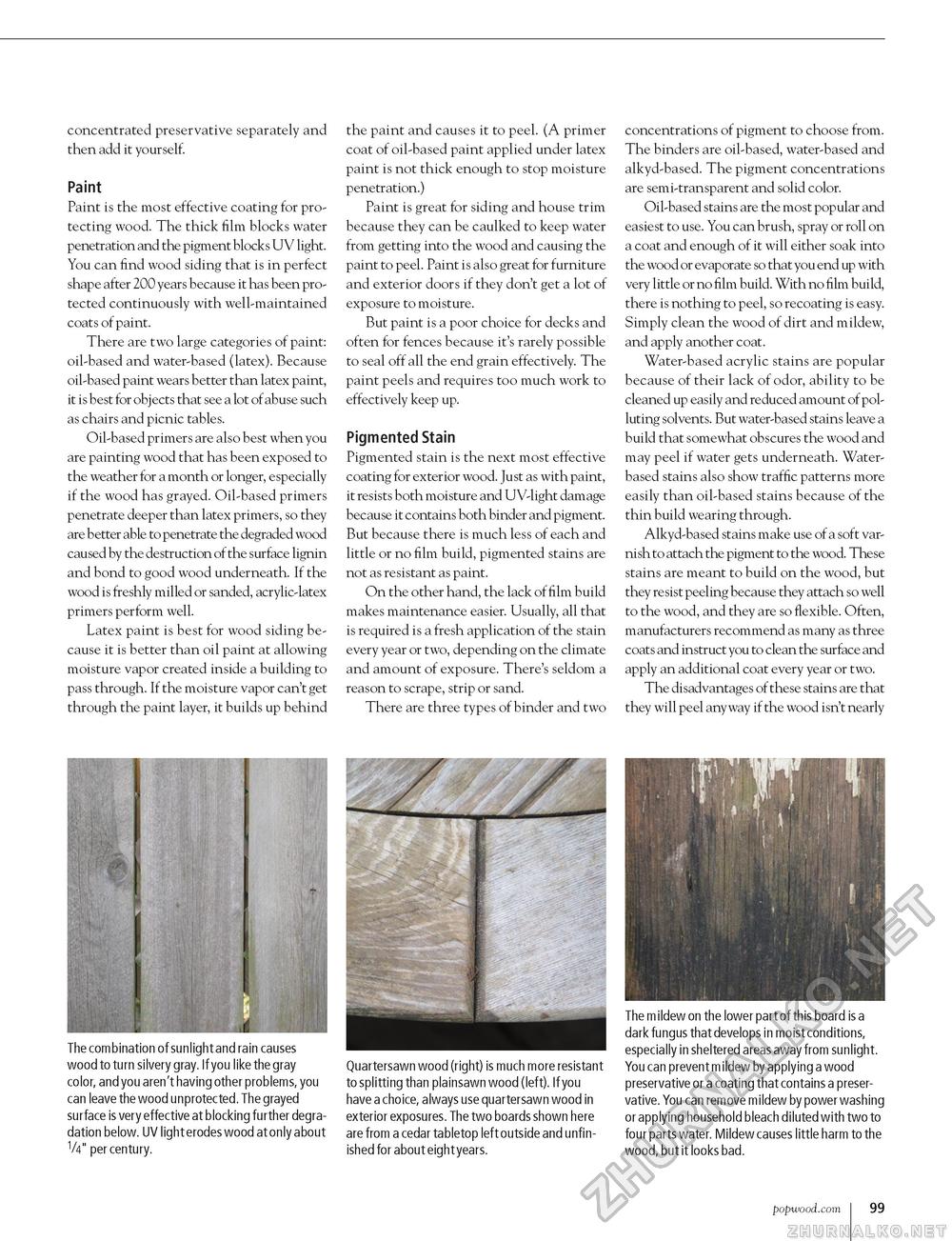Popular Woodworking 2005-04 № 147, страница 103
concentrated preservative separately and then add it yourself. Paint Paint is the most effective coating for protecting wood. The thick film blocks water penetration and the pigment blocks UV light. You can find wood siding that is in perfect shape after 200 years because it has been protected continuously with well-maintained coats of paint. There are two large categories of paint: oil-based and water-based (latex). Because oil-based paint wears better than latex paint, it is best for objects that see a lot of abuse such as chairs and picnic tables. Oil-based primers are also best when you are painting wood that has been exposed to the weather for a month or longer, especially if the wood has grayed. Oil-based primers penetrate deeper than latex primers, so they are better able to penetrate the degraded wood caused by the destruction of the surface lignin and bond to good wood underneath. If the wood is freshly milled or sanded, acrylic-latex primers perform well. Latex paint is best for wood siding because it is better than oil paint at allowing moisture vapor created inside a building to pass through. If the moisture vapor can't get through the paint layer, it builds up behind The combination of sunlight and rain causes wood to turn silvery gray. If you like the gray color, and you aren't having other problems, you can leave the wood unprotected. The grayed surface is very effective at blocking further degradation below. UV light erodes wood at only about V4" per century. the paint and causes it to peel. (A primer coat of oil-based paint applied under latex paint is not thick enough to stop moisture penetration.) Paint is great for siding and house trim because they can be caulked to keep water from getting into the wood and causing the paint to peel. Paint is also great for furniture and exterior doors if they don't get a lot of exposure to moisture. But paint is a poor choice for decks and often for fences because it's rarely possible to seal off all the end grain effectively. The paint peels and requires too much work to effectively keep up. Pigmented Stain Pigmented stain is the next most effective coating for exterior wood. Just as with paint, it resists both moisture and UV-light damage because it contains both binder and pigment. But because there is much less of each and little or no film build, pigmented stains are not as resistant as paint. On the other hand, the lack of film build makes maintenance easier. Usually, all that is required is a fresh application of the stain every year or two, depending on the climate and amount of exposure. There's seldom a reason to scrape, strip or sand. There are three types of binder and two Quartersawn wood (right) is much more resistant to splitting than plainsawn wood (left). If you have a choice, always use quartersawn wood in exterior exposures. The two boards shown here are from a cedar tabletop left outside and unfinished for about eight years. concentrations of pigment to choose from. The binders are oil-based, water-based and alkyd-based. The pigment concentrations are semi-transparent and solid color. Oil-based stains are the most popular and easiest to use. You can brush, spray or roll on a coat and enough of it will either soak into the wood or evaporate so that you end up with very little or no film build. With no film build, there is nothing to peel, so recoating is easy. Simply clean the wood of dirt and mildew, and apply another coat. Water-based acrylic stains are popular because of their lack of odor, ability to be cleaned up easily and reduced amount of polluting solvents. But water-based stains leave a build that somewhat obscures the wood and may peel if water gets underneath. Water-based stains also show traffic patterns more easily than oil-based stains because of the thin build wearing through. Alkyd-based stains make use of a soft varnish to attach the pigment to the wood. These stains are meant to build on the wood, but they resist peeling because they attach so well to the wood, and they are so flexible. Often, manufacturers recommend as many as three coats and instruct you to clean the surface and apply an additional coat every year or two. The disadvantages of these stains are that they will peel anyway if the wood isn't nearly The mildew on the lower part of this board is a dark fungus that develops in moist conditions, especially in sheltered areas away from sunlight. You can prevent mildew by applying a wood preservative or a coating that contains a preservative. You can remove mildew by power washing or applying household bleach diluted with two to four parts water. Mildew causes little harm to the wood, but it looks bad. popwood.com 99 |








